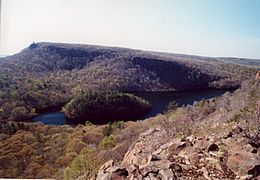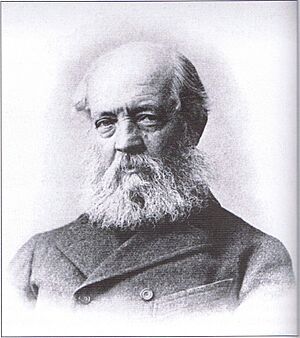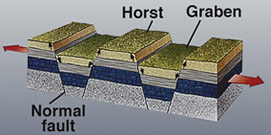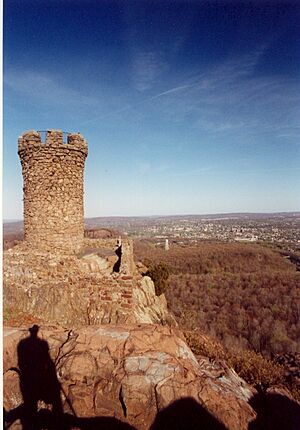Hanging Hills facts for kids
Quick facts for kids Hanging Hills |
|
|---|---|
| Metacomet Ridge | |

View of East Peak and Castle Craig from South Mountain, with Merimere Reservoir and Mine Island visible below
|
|
| Highest point | |
| Peak | West Peak |
| Elevation | 1,024 ft (312 m) |
| Dimensions | |
| Length | 3 mi (4.8 km) east-west |
| Geography | |
| Country | United States |
| Range coordinates | 41°33.45′N 72°49.4′W / 41.55750°N 72.8233°W |
| Geology | |
| Age of rock | Triassic and Jurassic |
| Type of rock | fault-block, igneous and sedimentary |
The Hanging Hills are a cool group of mountains in central Connecticut, USA. They are made of a special type of rock called trap rock. These hills look over the city of Meriden and the Quinnipiac River Valley, which is about 900 feet (274 meters) below.
These hills are part of a longer chain called the Metacomet Ridge. This ridge stretches from Long Island Sound all the way north to the Vermont border. The Hanging Hills are a great place for outdoor fun. They have unique mini-climates, rare plants, and amazing views from their tall cliffs. These cliffs rise sharply, more than 700 feet (213 meters) above the land around them.
The Hanging Hills are also home to Hubbard Park. This park covers 1,800 acres (7.3 square kilometers). It was designed with help from a famous landscape architect named Frederick Law Olmsted. The 51-mile (80-kilometer) Metacomet Trail also runs through these hills.
Contents
Exploring the Hanging Hills: Geography
The Hanging Hills are found in the towns of Meriden, Southington, and Berlin. They are shaped a bit like a horseshoe. Their steep cliffs face south and west.
The main peaks, from east to west, are:
- Cathole Mountain, which is 515 feet (157 meters) tall.
- South Mountain, at 767 feet (234 meters).
- East Peak, standing 976 feet (297 meters) high.
- West Peak, the tallest at 1,024 feet (312 meters).
On East Peak, you'll find a small stone tower called Castle Craig. It was built in 1900. The Metacomet Ridge continues north from here as Short Mountain and Ragged Mountain. It also goes southeast as Lamentation Mountain.
Most of the water from the south, east, and west sides of the Hanging Hills flows into the Quinnipiac River. This river then empties into Long Island Sound. Water from the north side goes into the Mattabesett River, then to the Connecticut River, and finally to Long Island Sound.
Several beautiful lakes and reservoirs are in or near the Hanging Hills. These include Kenmere Reservoir, Hallmere Reservoir, Elmere Reservoir, Beaver Pond, Silver Lake, Mirror Lake, and Slopers Ponds. Merimere Reservoir is especially pretty. It sits between South Mountain and East Peak and has a rocky island called Mine Island.
A Look Back: History of the Hills
Hubbard Park in the Hanging Hills was paid for by Walter Hubbard. He was a local business owner. Hubbard asked the famous landscape architect Frederick Law Olmsted to help design the park.
Edwin Howard Armstrong was a pioneer in radio. He invented FM radio. In 1939, he used West Peak for one of the first FM radio broadcasts ever. His original 70-foot (21-meter) radio tower is still on the peak today. West Peak is now home to seven FM radio stations. These include WPKT, WWYZ, WKSS, WDRC-FM, WZMX, WHCN, and WMRQ-FM.
How the Hills Were Made: Geology
The Hanging Hills were formed about 200 million years ago. This happened during the Triassic and Jurassic periods. They are made of a rock called trap rock, also known as basalt. Basalt is a dark rock that comes from volcanoes. The iron in the rock turns rusty brown when it touches air. This gives the cliffs a reddish color.
Basalt often breaks into cool shapes like octagons and pentagons. This makes a unique "postpile" look. You can see huge piles of broken basalt rock, called scree, below many cliffs. They are very clear at the base of East Peak, where it drops into Merimere Reservoir.
These basalt cliffs were created by several huge lava flows. The lava was hundreds of feet deep. It came up through cracks in the Earth when North America started to pull away from Eurasia and Africa. These lava floods happened over 20 million years. Between eruptions, layers of mud and sand built up. These layers later turned into sedimentary rock.
Imagine a layer cake tilted slightly. The basalt and sedimentary layers formed like this. Over time, the softer sedimentary layers wore away faster than the hard basalt. This left the tilted edges of the basalt layers sticking out. This is how the distinct ridges and dramatic cliffs we see today were formed. Later, moving glacial ice scraped away basalt from the southern ends of the ridges. This created the overhanging cliffs.
Nature's Home: Ecosystems
The Hanging Hills have special mini-climates that are rare in New England. The dry, hot upper ridges have oak savannas. These are open areas with chestnut oak trees and different grasses and ferns. Eastern red cedar trees, which like dry places, grow on the cliff edges.
Cooler, north-facing slopes have lots of eastern hemlock trees. These mix with the oak-hickory forest trees common in the lower areas. Narrow, shady ravines with hemlocks create cool, damp spots. These areas support plants that like cooler climates. Slopes made of broken rock are rich in nutrients. They have many calcium-loving plants that are not common in eastern Connecticut.
Because the trap rock ridges create so many different types of land, they are home to rare plants and animals. The Hanging Hills are also an important path for raptors (like hawks and eagles) when they migrate.
Fun in the Hills: Recreation
The Hanging Hills are a popular spot for outdoor activities. Hubbard Park has a stage for bands and beautiful flower gardens. It hosts many local events and concerts, like the spring Daffodil Festival. A road in the park leads to Castle Craig Tower. It's open from April to October, 10:00 a.m. to 5:00 p.m.
Many trails cross the hills. The most famous is the 51-mile (80-kilometer) blue-blazed Metacomet Trail. This trail is kept up by the Connecticut Forest and Park Association. You can go hiking, backcountry skiing, and snowshoeing on the trails. The park roads are open for bicycling and mountain biking. However, swimming is not allowed.
Rock climbing is not allowed in Hubbard Park. But you can enjoy it on Cathole Mountain. From the top of the many cliffs in the Hanging Hills, you can see a lot of the Quinnipiac River Valley. You can also see Long Island Sound and even distant peaks in southern New England.
Protecting the Hills: Conservation
Much of the Hanging Hills area is protected. It's set aside as parkland, for city water supply, or as conservation land. Private landowners also own a lot of land, especially on the east and north sides.
In 2000, the National Park Service studied the Hanging Hills. They were looking at making a new National Scenic Trail. This trail is now called the New England National Scenic Trail. It would include the Metacomet-Monadnock Trail in Massachusetts and the Mattabesett Trail and Metacomet Trail in Connecticut.
Several local groups work to protect the land and nature of the Hanging Hills. These include the Connecticut Forest and Park Association, the Meriden Land Trust, and the Berlin Land Trust.
The Mystery: The Black Dog of the Hanging Hills
The Black Dog of the Hanging Hills is a famous local legend. People say it's a ghostly dog that has been seen in the area since the early 1800s. The legend says it looks like a small, friendly black dog. It doesn't leave footprints and makes no sound.
According to the story, seeing the Black Dog once brings joy. Seeing it a second time is a warning. But seeing the Black Dog a third time is said to be a sign of death. At least six deaths have been blamed on people seeing the Black Dog for a third time.
One of the first stories about the dog was written in 1898. A geologist named W.H.C. Pynchon wrote about it. In 1891, he and another geologist, Herbert Marshall, were working in the Hanging Hills. They both saw the dog. Pynchon had seen it once before. Marshall had seen it twice, but he didn't believe the legend. Soon after they saw the dog, Marshall slipped on ice on a cliff and fell to his death. People still talk about the Black Dog today.






